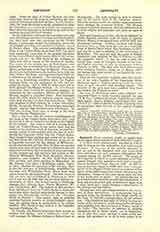

Capuciati (from caputium, hood), so named from the headgear which was one of their distinctive marks.
I. A short-lived confraternity founded in 1182 or 1183 in France for the restoration and maintenance of peace. It was one of the various attempts to put an end to the incessant wars and feuds which were spreading ruin and desolation throughout that country during the twelfth century. The origin of the Capuciati is traced to a poor carpenter of Le Puy, named Durand, who claimed to have had an apparition of the Blessed Virgin Mary in 1182. In this vision he received a paper on which there was a representation of the Blessed Virgin seated on a throne with a figure of the child Jesus in her hands, and bearing the inscription, “Lamb of God who takest away the sins of the world give us peace”. An association was to be formed whose members should bind themselves to keep and procure peace and, as distinctive signs, wear a white hood and a medal bearing a reproduction of the picture and inscription.
Durand met with astounding success in the execution of these instructions. A confraternity was organized under the direction of the clergy exactly on the lines of Catholic confraternities of the present day. The Church of Our, Lady of Le Puy became the center of the movement, which spread with extraordinary rapidity over the provinces of France, south of the Loire. The Capuciati, in addition to pledging themselves not to swear falsely, not to blaspheme, not to play dice, enter taverns, or wear costly garments, also promised to do all in their power to restore and maintain peace. Their endeavors in this line were not ineffectual, an overwhelming defeat which the “Routiers”, or undisciplined bands of soldiery of the period, sustained in 1183 must be largely ascribed to the cooperation of the Capuciati with the royal army. The existence of the confraternity was of short duration. Its disappearance is involved in obscurity; but it seems to have directed its efforts against the members of the nobility, and to have been wiped out of existence by them, aided by the “Routiers”. Its advocacy of heretical principles is not clearly and trustworthily indicated in historical records. The accusation that it respected neither ecclesiastical nor civil authority may perhaps be explained by its resistance to real or imagined abuses of power.
II. CAPUCIATI was also a designation applied to that special class of English Lollards who profited by the preaching and denunciations of the former Augustinian monk, Peter Pateshull (c. 1387), to indulge in deeds of iconoclasm. They owed their name to their practice of keeping the hoods on their heads in presence of the Blessed Sacrament. For fuller details as to these Capuciati, see Lollards.
N. A. WEBER

